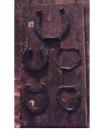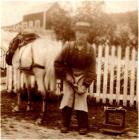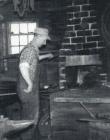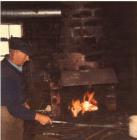1
William Henry Littlejohn established a blacksmith shop and forge in Coley's Point around 1900 and retired at age 68. He was followed in the business by his son William II. His grandson, William III, did not carry on the tradition but retained the artifacts and donated them to the Bay Roberts Heritage Society Inc. The Society recreated the forge in an exhibit in the "Road To Yesterday" Museum, Cable Building, Bay Roberts.3
When the weather permitted, the blacksmith could do the shoeing outdoors to escape the heat of the forge.4
The Forge - Road To Yesterday Museum2000
Road To Yesterday Museum, Cable Building, Water Street, Bay Roberts, Newfoundland, Canada
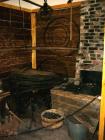
5
The practice of blacksmithing requires great skill but the process is simple. The blacksmith uses bellows to pump air into the fire raising the hearth temperature high enough to soften iron placed in it. He then hammers the metal into shape on the anvil and finally plunges the hot iron into water to harden it.The anvil was mounted on a wooden block, usually a tree trunk, just the right height so that the top of the anvil would be even with the smithy's knuckles when his arms hung straight down.
6
The Bellows - Forge Exhibit, Road to Yesterday Museum.2000
Road To Yesterday Museum, Cable Building, Water Street, Bay Roberts, Newfoundland, Canada
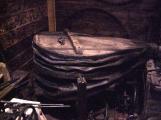
7
The Forge - Road To Yesterday Museum2000
Road To Yesterday Museum, Cable Building, Water Street, Bay Roberts, Newfoundland, Canada
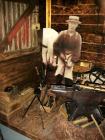
8
William Henry specialized in shoeing horses and making wheel rims and sled runners. A number of wheel rims are on display in the exhibit.10
During the 40's and 50's when trucks were replacing horses, William II began to supplement his farrier work by making U-bolts and iron knees for the wooden boxes on the stake body trucks.12
William Littlejohn II shoeing a horse in his forge.1955
Coley's Point, Bay Roberts, Newfoundland, Canada
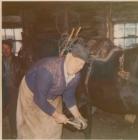
13
Horseshoe Display - Forge Exhibit, Road to Yesterday Museum.2000
Road To Yesterday Museum, Cable Building, Water Street, Bay Roberts, Newfoundland, Canada
